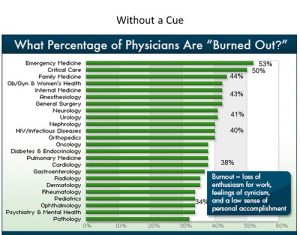Last month I attended a medical group meeting to shadow coach the leader. One of the biggest complaints that I hear from physicians as well as physician leaders is the vast amount of meetings where little to nothing gets accomplished and a lot of time gets wasted. And so to help leaders to improve his meeting facilitation and leadership style, I prefer to sit in the corner of the room observing the meeting from beginning to finish while jotting down notes for later conversations.
One thing that almost all medical group meetings have in common is PowerPoint presentations or handouts with lots of data and information. Now I know that physicians love data, and they love statistics, but even the most knowledge-driven profession can get overwhelmed with numbers and most attendees forget them before they leave the room.
When I asked the leader what his reasons were that he shared this massive amount of data, he wasn’t clear about his intention. And when he noticed that half the attendees left their handouts in the room, he realized
The thing is if people don’t remember your presentation and the point that you were trying to convey, there’s no point in making them at all. And so to make the presentation memorable and to get the attendees involved, we have to give people something that their brains can hold onto.
Neuroscientific researchers found out that the so-called “spatial cueing” will focus the eye and the brain on an intended target. Spatial cueing is nothing else than highlighting a specific part of a slide, where you color-circle or zoom the important data or fade out the rest of the slide.
Let me share with you an example.


The chart on the left has tons of numbers but no cues. Therefore it is really difficult to focus on one particular point and instead of focusing on the message the presenter has to share, the attendees’ eyes are rushing through the chart trying to find what is relevant to him. That exercise by itself can slightly increase stress sense. Additionally, since it is so hard to focus on one particular point, you probably won’t remember anything from this chart. However, the chart on the right side uses a colored circle to highlight the part of the chart that is relevant to the audience.
And so the next time you prepare a presentation to your group, think carefully about the single most important point that you want to make with every slide of your presentation. Even if you have a lot of data and you want the data to be visible for comparison, you still want to highlight the most critical points with a spatial cue. Without the cue, your audience will not know where to focus on your slide and they will waste neurological energy trying to remember unimportant information. Try it out and see for yourself or pay attention when you are an audience member. Little changes can make a big difference.
There were a few other suggestions for improvement that I shared with the physician leader after the meeting; however I will keep those for another article; after all, let me stick with one point per article. 😉
